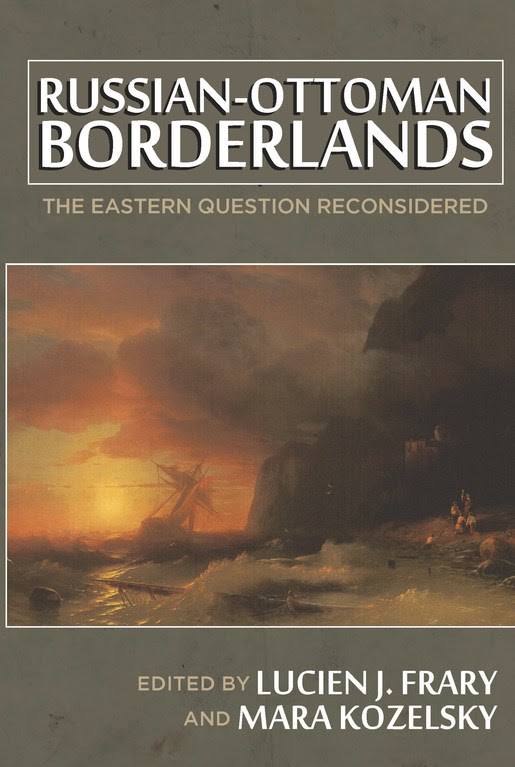.jpg) Mavi Boncuk | Russian-Ottoman Borderlands
Mavi Boncuk | Russian-Ottoman Borderlands The Eastern Question Reconsidered
Edited by Lucien J. Frary and Mara Kozelsky
An innovative and ambitious reassessment of one of the most dominant political concerns of the nineteenth century: What to do about a declining Ottoman Empire?
During the nineteenth century—as violence, population dislocations, and rebellions unfolded in the borderlands between the Russian and Ottoman Empires—European and Russian diplomats debated the “Eastern Question,” or, “What should be done about the Ottoman Empire?” Russian-Ottoman Borderlands brings together an international group of scholars to show that the Eastern Question was not just one but many questions that varied tremendously from one historical actor and moment to the next. The Eastern Question (or, from the Ottoman perspective, the Western Question) became the predominant subject of international affairs until the end of the First World War. Its legacy continues to resonate in the Balkans, the Black Sea region, and the Caucasus today.
The contributors address ethnicity, religion, popular attitudes, violence, dislocation and mass migration, economic rivalry, and great-power diplomacy. Through a variety of fresh approaches, they examine the consequences of the Eastern Question in the lives of those peoples it most affected, the millions living in the Russian and Ottoman Empires and the borderlands in between.
Lucien J. Frary is an associate professor of history at Rider University. Mara Kozelsky is an associate professor of history at the University of South Alabama.
See also:
Dreadful Scenes of Carnage on Both Sides”: The Strangford Files and the Eastern Crisis of 1821–1822 Theophilus C. Prousis
Lord Strangford, an experienced diplomatic official with previous postings to Portugal, Brazil, and Sweden, served as Britain’s ambassador to the Sublime Porte from 1821 to 1824, an especially turbulent time in Ottoman-European encounters. As the Ottoman Empire coped with a series of challenges, Strangford sent hundreds of reports to the London.
The Crimean War and the Tatar Exodus | Mara Kozelsky
In the years following the Crimean War (1853–56), nearly two-hundred thousand Crimean Tatars fled their native peninsula en masse to resettle in the Ottoman Empire. They abandoned their homes and livestock; sold their property at devastatingly low prices; gave up their poddanstvo, or subjecthood in the Russian Empire; and bid farewell to the country...
Slaves of the Sultan: Russian Ransoming of Christian Captives during the Greek Revolution, 1821–1830 | Lucien J. Frary
The people of Russian lands were involved in the Crimean Tatar and Ottoman slave trade from at least the second half of the fifteenth century.1 By the sixteenth century, Crimean Tatars, Nogais, Kalmyks, and Kazakhs raided Russian territories annually, with the goal of enslaving as many Russians as they could take away.
Russia’s Quest for the Holy Grail: Relics, Liturgics, and Great-Power Politics in the Ottoman Empire Jack Fairey
A development common to all the social sciences since the end of the Cold War has been a renewed appreciation for the social and political power of religion.1 In keeping with this trend, a growing number of historians have self-consciously sought (in the words of Philip Gorski) “to bring religion back in” to the writing of modern political and social...
“Forty Years of Black Days”? The Russian Administration of Kars, Ardahan, and Batum, 1878–1918 Candan Badem
This chapter examines the basic tenets of the Russian “Military-Customary Administration” (Voenno-narodnoe upravlenie) and the Russian resettlement (colonization) policy in Kars, Ardahan, and Batum from the Russian annexation in 1878 until the Treaty of Brest-Litovsk in 1918.
Squabbling over the Spoils: Late Imperial Russia’s Rivalry with France in the Near East Ronald P. Bobroff
The Franco-Russian Alliance, from its beginnings in 1891 through its demise with the Russian Revolution in 1917, is best remembered for the way France and Russia cooperated primarily to resist what was perceived as a growing threat from Germany. Indeed, this alliance formed one side of a diarchy of alliances that engendered the tensions facilitating... read more
The Eastern Question in Turkish Republican Textbooks: Settling Old Scores with the European and the Ottoman “Other” Nazan Çiçek
On a cold January day in 1923 in Eskişehir, a small Anatolian town near Ankara, Mustafa Kemal (Atatürk) gave a lengthy speech to the officials and notables who had gathered at the governor’s office to hear him. During the address, which touched upon many pressing matters, Mustafa Kemal discussed the Lausanne Conference (1922–23)
Epilogue: Legacies of the Eastern Question Lucien J. Frary, Mara Kozelsky
Macedonia Square, the central meeting place in Skopje, Republic of Macedonia, is part of an ambitious “antiquization” project financed by the government that reflects the bustling capital as a historical crossroads. Synthesizing more than two millennia of history, the square’s centerpiece features an enormous white marble fountain with a...